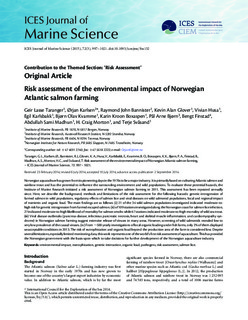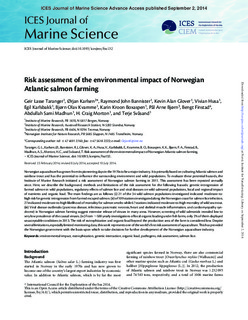| dc.identifier.citation | Taranger, G. L., Karlsen, Ø., Bannister, R. J., Glover, K. A., Husa, V., Karlsbakk, E., Kvamme, B. O., Boxaspen, K. K., Bjørn, P. A., Finstad, B., Madhun, A. S.,Morton, H. C., and Sva˚sand, T. Risk assessment of the environmental impact of Norwegian Atlantic salmon farming. – ICES Journal of Marine Science, doi: 10.1093/icesjms/fsu132. | nb_NO |
| dc.description.abstract | Norwegian aquaculture has grown from its pioneering days in the 1970s to be a major industry. It is primarily based on culturing Atlantic salmon and rainbow trout and has the potential to influence the surrounding environment and wild populations. To evaluate these potential hazards, the Institute of Marine Research initiated a risk assessment of Norwegian salmon farming in 2011. This assessment has been repeated annually since. Here, we describe the background, methods and limitations of the risk assessment for the following hazards: genetic introgression of farmed salmon in wild populations, regulatory effects of salmon lice and viral diseases on wild salmonid populations, local and regional impact of nutrients and organic load. The main findings are as follows: (i) 21 of the 34 wild salmon populations investigated indicated moderate-to-high risk for genetic introgression from farmed escaped salmon. (ii) of 109 stations investigated along the Norwegian coast for salmon lice infection, 27 indicated moderate-to-high likelihood of mortality for salmon smolts while 67 stations indicated moderate-to-high mortality of wild sea trout. (iii) Viral disease outbreaks (pancreas disease, infectious pancreatic necrosis, heart and skeletal muscle inflammation, and cardiomyopathy syndrome) in Norwegian salmon farming suggest extensive release of viruses in many areas. However, screening of wild salmonids revealed low to very low prevalence of the causal viruses. (iv) From ∼500 yearly investigations of local organic loading under fish farms, only 2% of them displayed unacceptable conditions in 2013. The risk of eutrophication and organic load beyond the production area of the farm is considered low. Despite several limitations, especially limited monitoring data, this work represents one of the world’s first risk assessment of aquaculture. This has provided the Norwegian government with the basis upon which to take decisions for further development of the Norwegian aquaculture industry. | nb_NO |


